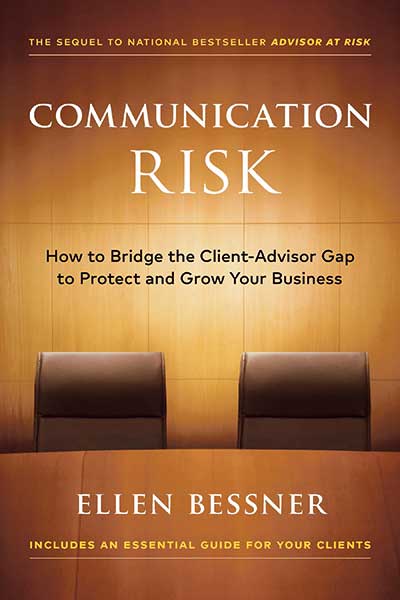The first time I heard Ellen Bessner speak at a conference, she scared the heck out of me and, I suspect, every financial advisor in the audience. Part of the reason was her no-holds-barred presentation style. Even more compelling was her obvious passion for helping advisors understand the likelihood, severity and consequences of the risks they face every day with every client.
Bessner’s first book, Advisor at Risk: A Roadmap to Protecting Your Business, published in 2008, shone a light on the potential pitfalls that can put even the most well- intentioned and compliant advisor in jeopardy.
Bessner’s latest offering, Communication Risk: How to Bridge the Client-Advisor Gap to Protect and Grow Your Business, takes the next step. The book highlights the core issue that threatens client/advisor relationships: lack of communication or miscommunication – the same cause of discord in most personal relationships. The difference between business and personal situations is that the consequences can be more far-reaching and punishing in the former.
Based on Bessner’s years as a lawyer defending advisors under investigation due to client complaints, she has concluded that there are three primary reasons for the communication gap:
– clients may have unrealistic expectations;
– what clients say isn’t necessarily what they mean;
– clients may not always tell you everything you need to know.
You could assume that all three causes can be addressed through a well-conducted “know your client” (KYC) process. Unfortunately, most KYC forms used by advisory firms today – and the resulting matching of client needs and risk profiles with an “acceptable” portfolio – are woefully inadequate. These KYC platforms require only a cursory self-assessment by the client and many platforms use algorithms that have little, if any scientific validation.
Bessner dives deeper into the subject of suitability in Communication Risk, as she did in Advisor at Risk, noting that suitability is far and away the basis of most client complaints and litigation. I looked back to my review of the first book, which I wrote 10 years ago, and was surprised to see a significant amount of content devoted to this topic. During the past decade, suitability has become a top concern among securities regulators worldwide, meaning we can expect much more stringent requirements for advisors.
Bessner was ahead of her time then, and now she suggests the new regime for risk profiling will include issues such as:
– Tolerance. How willing is the client to assume risk?
– Capacity. How much risk can the client afford to take?
– Loss. How much downside can the client absorb?
– Composure. How will the client behave under stress?
– Need. How much risk does the client need to take?
– Perception. How much is the client influenced by markets and the media?
In Bessner’s view, the best way to answer these questions is through a comprehensive financial planning exercise. Not one that simply follows a template, but one that engages your clients in a meaningful conversation about both their emotional and their financial well-being.
As important as an enhanced KYC process is, Bessner suggests, it’s not enough. You also should have a “know yourself” process that exposes your strengths, weaknesses, partialness and beliefs. Awareness of these personal characteristics can help you mitigate the risk of having your biases unduly influence your recommendations.
Similarly, she encourages you to perform a “know your business” self-evaluation. This process helps you define the parameters within which you are educated, skilled and motivated to provide the highest quality of advice. Being able to articulate what you’re good at and enjoy doing will go a long way toward setting your clients’ realistic expectations about the work you can do on their behalf.
Finally, along the same lines, Bessner suggests you complete a “know your product” assessment to avoid “turning product risks into advisor risks.” With enhanced knowledge of the characteristics of the products you recommend, you can explain the advantages and risk more fully and clearly.
Communication Risk includes chapters on dealing with female clients (don’t stereotype all women as being risk-averse) and seniors. The latter group, unfortunately, has been victimized too often through misunderstanding, misplaced trust and outright fraud. This reality imposes additional requirement on advisors who deal with seniors to meet advisors’ obligations from a legal perspective, such as powers of attorney and the client’s capacity to make informed decisions.
Bessner tells her stories through disguised real-life cases and offers specific advice on how to avoid risks and, if unavoidable, how to deal with them. Communication Risk – like Advisor at Risk – includes an “advisor action plan” at the end of each chapter to guide you through the process of bridging the communication gap.
This time, Bessner also offers a guide for clients, entitled Investor’s Guide: How to Get the Most From Your Registered Advisor. The guide is intended to convey to clients the importance of clear communication and transparency in their advisor relationships.
Communication Risk: How to Bridge the Client-Advisor Gap to Protect and Grow Your Business
by Ellen Bessner, Babin Bessner Spry; 268 pages, $29.95
*****
